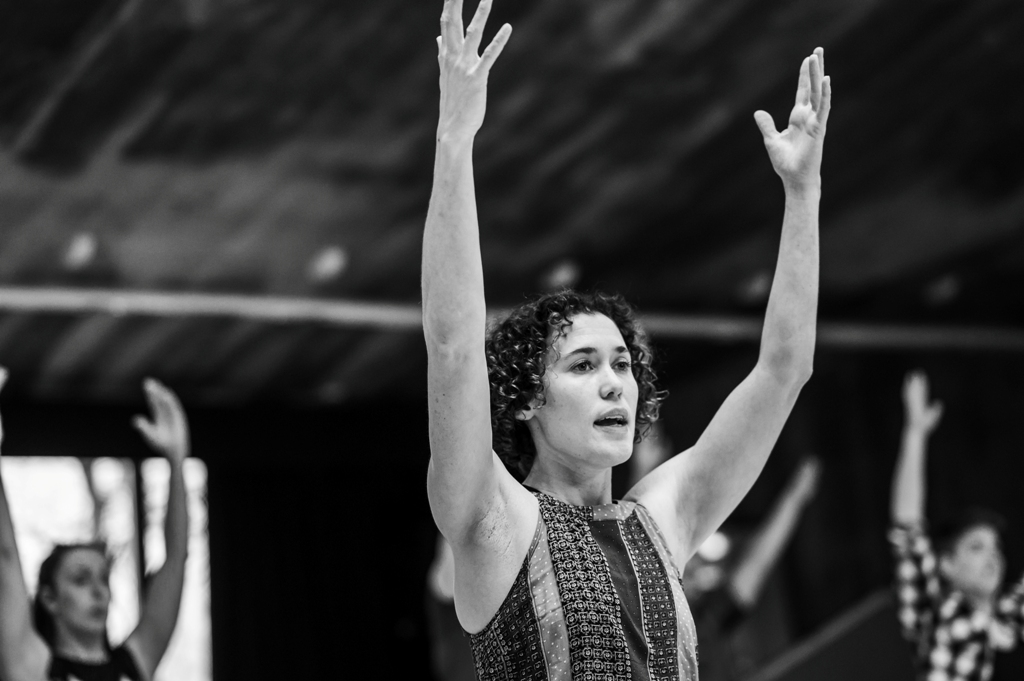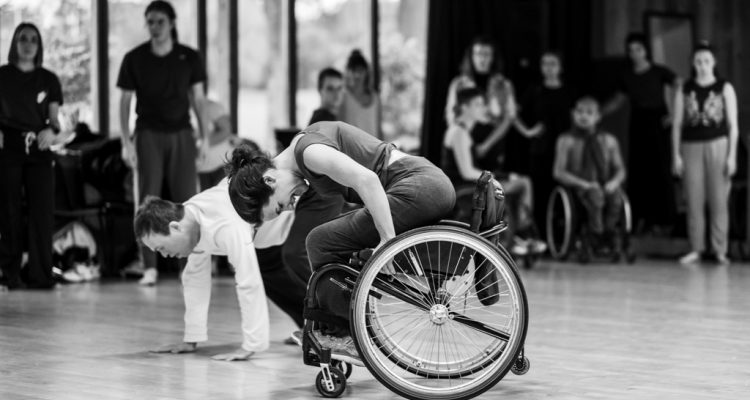Amy Butler re-examines the dancer’s comfort zone, the role Home Practice plays in learning at home and themes of exploration for future sessions…

A black and white photo of Amy Butler leading class in a studio, she has both arms raised.
How do we continue to take ourselves out of our comfort zone whilst learning and training from home?
Perhaps first I should discuss what I mean by ‘comfort zone’. In the past my experience of the use of this term has actually been quite negative, so, for the purpose of this blog I would like to define what I mean and perhaps, reclaim its use.
As a dancer and performer, I have had the privilege to work with a wide range of choreographers and directors and each of which has had a specific approach to developing work. Unfortunately, not all of my experiences have been pleasant, though it is some of the more difficult situations that I have learnt the most from.
Anyway, I digress. One particular choreographer was obsessed by using the term ‘get out of your comfort zone’, usually with the intent of wielding power and very rarely for the benefit of the dancer’s professional development.
When I use this collection of words I am trying to analyse how the development of our Home Practice on YouTube can keep encouraging participants to test their physical and intellectual capacity to learn. We do not want to imitate what happens in the studio but rather offer an opportunity to invest in one’s self practice. For me it is important that part of what we offer is about complexity, providing tutorials that actively work to open new doors and take what is already known to a new level. This is what I mean by taking oneself out of the ‘comfort zone’.
Speaking from my own personal experience of training, learning, and teaching from home, there have been times when my motivation has slipped. In the studio there is always a colleague or friend there to inspire me and draw me back in, often encouraging me to discover new material, define existing sequences or practice movement to a high level. After many weeks of working from home and for some perhaps many more to come, we now have to dig deep to keep inspired and invest in ourselves and our own learning. The content of our Home Practice sessions has the potential to offer much needed support in doing this.
For one, we hope to retain a real connection with those individuals taking the classes through actively encouraging feedback, responding to comments, and eventually providing live platforms to discuss and question the content and how it can be developed upon. We will not be able to replace those colleagues, friends and teachers that are currently missing, but we will be more present and available than teachers in so many other online resources.
The athleticism that is often associated with high level dance is not appropriate to work with when asking people to participate from their homes; it is not safe and again we are not trying to re-create studio practice. So, how can we take our physicality and acquisition of movement material to a new level?
Here are just a few ideas and themes that I hope to explore in my Home Practice sessions:
Musicality: How can we fine tune our body like an instrument? Play with complex rhythms and sequencing, how do we surprise through stretching and compressing time? We will look at developing a new language through the understanding and application of musical terminology.
Coordination: Everyone can work to improve their coordination, it is a totally accessible skill, no matter your learning style or physical make-up you can always work on improving this area of body intelligence. I am not suggesting that all exercises involving coordination are accessible but that the concept of improved coordination in relation to your own mind and body is. It can also improve efficiency and one’s ability to learn movement.
Dynamic play: developing our capacity to move at speed even in a restricted space. How can we project movement? How can we contain movement? In this new learning environment what does it take to turn up the volume?
Understanding the systems of the body and then disrupting this in order to find more options: exploring the organs, bones, muscles and skin and improving our comprehension of these layers of the body and then rediscovering them in a way that challenges what we think we know.
Working with the minute: understanding the entirety of a movement down to the placement of the chin, fingers and toes. Can we begin movement from the microscopic? What detail can we add like the seasoning to a fine meal? Can we layer more complexity onto a form that we already know?
These are just some of the ideas I hope to explore in my Home Practice sessions, my aim being to provide an opportunity to explore, discover and challenge. I feel so privileged to be able to support the dance community in this way and am excited to share my offerings.


